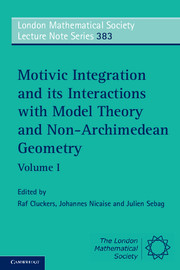Book contents
- Frontmatter
- Contents
- List of contributors
- 1 Introduction
- 2 Introductory notes on the model theory of valued fields
- 3 On the definition of rigid analytic spaces
- 4 Topological rings in rigid geometry
- 5 The Grothendieck ring of varieties
- 6 A short course on geometric motivic integration
- 7 Motivic invariants of rigid varieties, and applications to complex singularities
- 8 Motivic integration in mixed characteristic with bounded ramification: a summary
- References
3 - On the definition of rigid analytic spaces
Published online by Cambridge University Press: 07 October 2011
- Frontmatter
- Contents
- List of contributors
- 1 Introduction
- 2 Introductory notes on the model theory of valued fields
- 3 On the definition of rigid analytic spaces
- 4 Topological rings in rigid geometry
- 5 The Grothendieck ring of varieties
- 6 A short course on geometric motivic integration
- 7 Motivic invariants of rigid varieties, and applications to complex singularities
- 8 Motivic integration in mixed characteristic with bounded ramification: a summary
- References
Summary
In his seminar notes [5] on Rigid Analytic Spaces, Tate developed a powerful analogue of classical complex analysis over complete non-Archimedean fields. The toplogy of such a field K is quite weak, as it is totally disconnected. For example, any disk in K may be viewed as a disjoint union of smaller disks. Therefore a local definition of analyticity cannot yield useful global results of the type we know them from complex analysis. For example, this concerns global identity theorems and also the fact that analytic functions on classical projective spaces are constant.
Following the method from complex analysis and looking at functions admitting local power series expansions, we end up with so-called locally analytic spaces, or wobbly analytic spaces in the terminology of [5]. Since these are lacking connectivity in the non-Archimedean case, Tate equipped them with an additional structure, a so-called h-structure, which provides a certain substitute for connectivity. All this is guided by the idea that polydisks in affine n-spaces should be viewed as being “connected” and that their analytic functions should admit globally convergent power series expansions.
Having such an idea in mind, there is another theory, which provides useful guidance, namely, the theory of Grothendieck's schemes (of locally finite type over K).
- Type
- Chapter
- Information
- Motivic Integration and its Interactions with Model Theory and Non-Archimedean Geometry , pp. 80 - 102Publisher: Cambridge University PressPrint publication year: 2011



